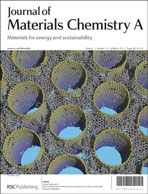A general conversion of polyacrylate–metal complexes into porous carbons especially evinced in the case of magnesium polyacrylate†
Abstract
As a generalized synthetic protocol, porous carbons have been for the first time prepared by a direct carbonization of polyacrylate–metal complexes. The case of magnesium polyacrylate was emphatically studied. It reveals that the carbonization temperature can play a crucial role in the determination of surface areas, pore structures, surface functionalities of porous carbons as well as the correlative capacitive performances. The carbon-Mg-900 sample exhibits a high surface area of 942 m2 g−1 and a large total pore volume of 1.90 cm3 g−1, with a high specific capacitance of 262.4 F g−1 at 0.5 A g−1 in 6.0 mol L−1 aqueous


 Please wait while we load your content...
Please wait while we load your content...